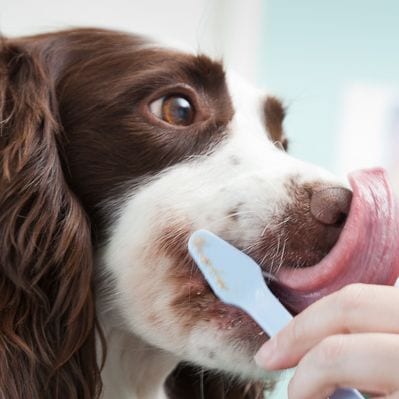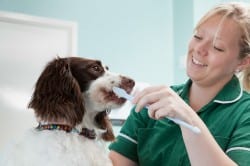Is there someone close to you with ‘Dog’s Breath’!
There is no doubt we are a nation of animal lovers but when it comes to our much loved pet’s health and welfare there’s a shocking statistic that we should all be aware of, 80% of dogs and cats in this country over the age of three have some degree of dental disease!
The harsh reality is 4 out of every 5 pets are suffering with painful or infected mouths, and they often suffer unnoticed for many years with serious consequences to their long term health. You may assume that your pets are the lucky ones but have you checked their mouths recently?
As owners we don’t tend to regularly check out pet’s teeth. Often dogs and cats are reluctant to have their mouths examined (especially if they are painful!) and if we’re honest about it they may smell! After all the derogatory phrase, ‘having dog’s breath’ has been used for centuries! Well the news is that if your dog’s mouth is healthy IT DOESN’T SMELL, so if it’s a bit whiffy the likelihood is your dog is one of the 4 out of 5. Bad breath generally means infection I’m afraid. As for examining the mouth, you don’t have to be a vet and there’s no need to wrench the jaws wide open, just lift up the lip a little on each side – swollen red gums, tartar or broken teeth are obvious.
When it comes to dental pain unfortunately dogs and cats hide it better than you or I and that is probably their biggest problem. Whereas we will happily complain to anyone that will listen about the slightest dental discomfort our pets on the other hand struggle on, it’s part of their DNA to hide signs of weakness. Most animals will continue eating with significant dental pain because to stop means that the pain is so great that the only option they have left is to starve themselves, frequently it is only at this stage that we as owners realise something could be wrong.
Losing teeth and a loss of appetite is also only part of the problem, any human dentist would confirm the links in people between peridontal disease and heart attacks or strokes. In pets the bacteria from the mouth will also travel around the circulation affecting distant organs such as the heart,liver and kidneys having adverse effects on them also.
Well what should we do? Well if you have any concerns speak to the vet! A check up and a routine descale and polish may be essential at the very least, but in addition there are a few home care tips that are important:
Firstly make a point to check out your pet’s teeth!
Secondly tooth brushing is the corner stone of treatment, if you’re not doing this you really should begin. Starting from an early age certainly early helps with complience but it’s never too late to give it a go. Brushing should be part of the daily regime (sorry yes I did say daily) and aim to make it a positive bonding experience with your pet. Be patient, start by rubbing the face and muzzle so your dog is used to you petting this area. Do this for 30 seconds before rewarding them with fuss, play and a treat! Do this for 5 days in a row. After this try using some toothpaste, DON’T use human toothpaste it can be toxic to your pet if swallowed, we recommend Logic Oral Hygiene Gel. Don’t go straight to using a toothbrush, use a finger or ‘finger brush’ first of all and allow the pets to taste the gel. Gently keep the mouth closed to relax the lips and start gently brushing the teeth, begin at the canines and work back towards the molars. Remember REWARD at the end of each session and stop if there is any sign of aggression or distress.
Chlorhexidine oral rinses (Hexarinse) or gels are also a useful treatment option. Chlorhexidine kills bacteria in the mouth and can last for 18 hours, this can be great in cats that are more resistant to brushing as the product can be applied via a cotton wool bud.
When it comes to diet and chews I’m afraid this is only part of the solution and not a replacement for tooth brushing. Beware of dogs and bones! “But bones are good for dog’s teeth” I hear you say, “surely everyone knows that!” – well actually the jury’s out on this popular misconception. Bones can be very hard and chewing hard bones too vigourously can result in fractured teeth, a painful form of dental disease. Naturally dogs would have chewed on bones it’s true but that doesn’t mean these dogs didn’t suffer dental disease. Softer specifically designed chews are helpful and chewing should be encouraged for 30mins a day for dogs but beware of the calories and don’t rely on this method solely. Of course never ever give cooked bones which will splinter dangerously when chewed!
For cats in particular where chews are not an option (but also for dogs who have no interest in chews!) using Hills t/d is well worthwhile, the biscuits are larger than normal kibble but have a softer consistency which doesn’t shatter when chewed but instead cleans the surface of the tooth as it’s bitten in two. Hills t/d biscuits are clinically proven to reduce the accumulation of plaque and tartar and are extremely palatable.
There are also seaweed derivatives and some drinking water additives that may also help in the fight against dental disease and we are happy to offer advice about these options at reception.
If you make the effort to look after your pet’s teeth it’s amazing what a difference a healthy mouth can make to their quality of life, I’ve heard countless people comment on being shocked how much happier their animal is after a dental. The real challenge though is keeping on top of the teeth cleaning longterm, I’m off to try and practice what I preach…..watch out Arthur here comes the Logic Gel!
< Back to articles Estcourt Vets Devizes
Estcourt Vets Devizes
